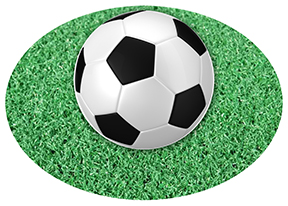The Dirt on Artificial Turf
The Dirt on Artificial Turf
http://www.preventcancernow.ca/the-dirt-on-artificial-turf
By Meg Sears, PhD
The summer mantra of Mums … “Go out and play, run and have fun, play with your friends!” … but where? We all do better with time in nature, and sports are important too.
As wilder weather, droughts and scorching sun make it harder to maintain natural grass fields, some jurisdictions are looking to artificial turf for more reliable playing surfaces and more usable days. Artificial turf is also used for all-season play indoors. It may not be all fun and games, however, as highlighted most recently in an apparent cancer cluster among soccer goalies. Among 27 players with cancer, 22 are goalies. Diving for balls, they breathe and ingest considerably more rubber crumb than other players.
What is artificial turf?
Modern artificial turf is a plastic weave with “grass” strands. This is typically polyethylene, with additives such as heavy metals for stability in sunlight. Crumb rubber from recycled tires is under and around the strands, and becomes airborne with impact.
What is in “the dirt”?
The US Environmental Protection Agency found that artificial turf contains toxic metals such as lead, cadmium and mercury. Cancer-causing and otherwise toxic chemicals can dissolve in rainwater as well as off-gas, especially in the sun. The Centers for Disease Control and Prevention reported potentially worrisome levels of lead in dust on older fields (only lead was measured). A recent review acknowledges toxic hydrocarbons and metals may enter the air and water from artificial turf, although levels vary widely and are sometimes comparable to other sources of urban pollution such as from vehicle exhaust.
What does this mean for the goalies? We don’t really know. Research is needed to mimic their exposures. As well, indoor fields may be poorly ventilated during Canadian winters, with strong odours in facilities. This situation also needs study.
Other concerns
Artificial turf is promoted for its low water requirements, but as a direct consequence these fields become extremely hot in the sun. Cooling of players and sometimes the field is required, with ample hydration and misting.
Tire recycling is improving rapidly, as rubber is incorporated in solid, durable products. Over time, the crumb ages and forms dust that is more readily inhaled, and artificial turf fields must be renovated and replaced, with old materials not necessarily being recovered.
The bottom line
Artificial turf is a fact of life for many athletes. PCN recommends to:
- Ensure ample ventilation in indoor facilities.
- Wash hands and face well before eating, and minimize ingestion of dust and rubber.
- Keep water bottles off the ground.
- Whenever possible play on natural surfaces. This is particularly important for younger children.
- Test the crumb for toxic chemicals (crumb quality can vary widely according to the US EPA), as well as the water runoff.
- If you are installing a new field consider a variety of innovative options, and ask tough questions of suppliers regarding the content, toxicity, durability, and eventual fate of artificial turf.
Meg Sears is a Board member of Prevent Cancer Now
www.preventcancernow.ca


Comments are closed.